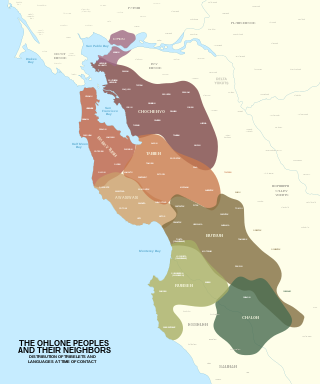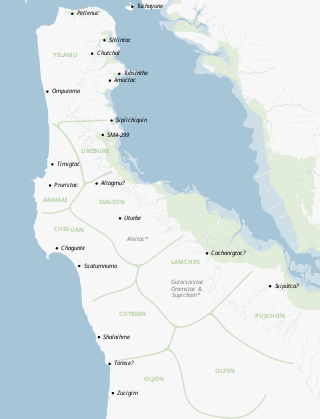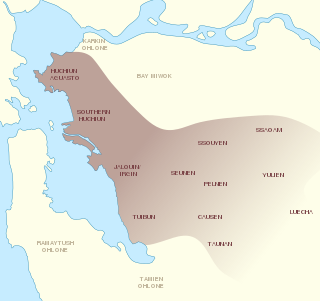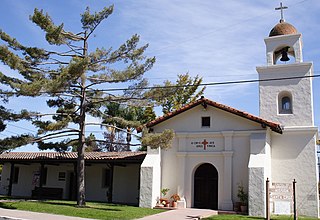| Karkin | |
|---|---|
| Native to | United States |
| Region | California |
| Ethnicity | Karkin people |
| Extinct | 1950s [1] |
| Language codes | |
| ISO 639-3 | krb |
| Glottolog | kark1259 |
The Karkin language (also called Los Carquines in Spanish) is an extinct Ohlone language. It was formerly spoken in north central California, but by the 1950s there were no more native speakers. [1] The language was historically spoken by the Karkin people, who lived in the Carquinez Strait region in the northeast portion of the San Francisco Bay estuary. [2]
Karkin's only documentation is a single vocabulary obtained by linguist-missionary Felipe Arroyo de la Cuesta at Mission Dolores in 1821. [3] Although meager, the records of Karkin show that it constituted a distinct branch of Ohlone, strikingly different from the neighboring Chochenyo Ohlone language and other Ohlone languages spoken farther south. [4]

The Ohlone, formerly known as Costanoans, are a Native American people of the Northern California coast. When Spanish explorers and missionaries arrived in the late 18th century, the Ohlone inhabited the area along the coast from San Francisco Bay through Monterey Bay to the lower Salinas Valley. At that time they spoke a variety of related languages. The Ohlone languages make up a sub-family of the Utian language family. Older proposals place Utian within the Penutian language phylum, while newer proposals group it as Yok-Utian.

The Rumsen language is one of eight Ohlone languages, historically spoken by the Rumsen people of Northern California. The Rumsen language was spoken from the Pajaro River to Point Sur, and on the lower courses of the Pajaro, as well as on the Salinas and Carmel Rivers, and the region of the present-day cities of Salinas, Monterey and Carmel.
The Bay Miwok are a cultural and linguistic group of Miwok, a Native American people in Northern California who live in Contra Costa County. They joined the Franciscan mission system during the early nineteenth century, suffered a devastating population decline, and lost their language as they intermarried with other native California ethnic groups and learned the Spanish language.

Utian is a family of indigenous languages spoken in Northern California, United States. The Miwok and Ohlone peoples both spoke languages of the Utian language family. It has recently been argued that the Utian languages and Yokuts languages are sub-families of the Yok-Utian language family. Utian and Yokutsan have traditionally been considered part of the Penutian language phylum.
The Lamchin were one of many tribes of the Ohlone (Coastanoan) people, Native Americans who lived along the San Francisco Peninsula. The Lamchin were the native inhabitants of what is now San Carlos, California. Information is sparse and dispersed, coming mostly from Spanish mission records - as the natives had no written language. The collected information follows over 100 years of research by many noted historians. The Lamchin are believed to be extinct - as historical, statistical and limited written accounts would seem to indicate.

The Ramaytush or Rammay-tuš people are a linguistic subdivision of the Ohlone people of Northern California. The term Ramaytush was first applied to them in the 1970s, but the modern Ohlone people of the peninsula have claimed it as their ethnonym. The ancestors of the Ramaytush Ohlone people have lived on the peninsula—specifically in the area known as San Francisco and San Mateo county—for hundreds of years. Prior to the California Genocide, the Ohlone people were not consciously united as a singular socio-political entity. In the early twentieth century anthropologists and linguists began to refer to the Ramaytush Ohlone as San FranciscoCostanoans—the people who spoke a common dialect or language within the Costanoan branch of the Utian family. Anthropologists and linguists similarly called the Tamyen people Santa Clara Costanoans, and the Awaswas people Santa Cruz Costanoans.

The Yelamu are a local tribe of Ohlone people from the San Francisco Bay Area in Northern California. The Yelamu speak a language called Ramaytush. The modern Association of Ramaytush Ohlone (ARO) are the descendants of the Ramaytush.

The Chalon people are one of eight divisions of the Ohlone (Costanoan) people of Native Americans who lived in Northern California. Chalon is also the name of their spoken language, listed as one of the Ohlone languages of the Utian family. Recent work suggests that Chalon may be transitional between the northern and southern groups of Ohlone languages.

The Awaswas people, also known as Santa Cruz people, are one of eight divisions of the Ohlone Native Americans of Northern California. The Awaswas lived in the Santa Cruz Mountains and along the coast of present-day Santa Cruz County from present-day Davenport to Aptos. The name for this area in Awaswas was Aulinta.

The Tamien people are one of eight linguistic divisions of the Ohlone (Costanoan) people groups of Native Americans who lived in Northern California. The Tamien traditionally lived throughout the Santa Clara Valley. The use of the name Tamien is on record as early as 1777, it comes from the Ohlone name for the location of the first Mission Santa Clara on the Guadalupe River. Father Pena mentioned in a letter to Junipero Serra that the area around the mission was called Thamien by the native people. The missionary fathers erected the mission on January 17, 1777 at the native village of So-co-is-u-ka.

The Chochenyo are one of the divisions of the indigenous Ohlone (Costanoan) people of Northern California. The Chochenyo reside on the east side of the San Francisco Bay, primarily in what is now Alameda County, and also Contra Costa County, from the Berkeley Hills inland to the western Diablo Range.
Tamcan or Tammukan was a local tribe of Delta Yokuts-speaking natives in the U.S. that once lived on the lower reaches of California's San Joaquin River in what is now eastern Contra Costa County and western San Joaquin County, California. The Tamcans were absorbed into the system of the Spanish missions in California in the early nineteenth century; they moved to Mission San José, near the shore of San Francisco Bay, between 1806 and 1811. At the mission, they and their descendants intermarried with speakers of the San Francisco Bay Ohlone, Plains Miwok, and Patwin Indian languages. Mission Indian survivors of these mixed groups gathered at Alisal, near Pleasanton in Contra Costa County, in the late nineteenth century.

The Ohlone languages, also known as Costanoan, are a small family of indigenous languages spoken by the Ohlone people. The pre-contact distribution of these languages ranged from the southern San Francisco Bay Area to northern Monterey County. Along with the Miwok languages, they are members of the Utian language family. The most recent work suggests that Ohlone, Miwok, and Yokuts are branches of a Yok-Utian language family.
The Chalon language is one of eight Ohlone languages, historically spoken by the Chalon people of Native Americans who lived in Northern California. Also called Soledad, it belongs to the one of the Ohlone languages of the Utian family. Recent work suggests that Chalon may be transitional between the northern and southern groups of Ohlone languages.
The Tamyen language is one of eight Ohlone languages, once spoken by Tamyen people in Northern California.
The Ramaytush language is one of the eight Ohlone languages, historically spoken by the Ramaytush people who were indigenous to California. Historically, the Ramaytush inhabited the San Francisco Peninsula between San Francisco Bay and the Pacific Ocean in the area which is now San Francisco and San Mateo Counties. Ramaytush is a dialect or language within the Ohlone branch of the Utian family. The term Ramaytush was first applied to it during the 1970s.

The Rumsen are one of eight groups of the Ohlone, an indigenous people of California. Their historical territory included coastal and inland areas within what is now Monterey County, California, including the Monterey Peninsula. Today, like other Ohlone, Rumsen do not have federal recognition but continue to sustain their culture and community presence in central California. This is despite the fact the Rumsen signed a treaty with the United States: the Treaty of Camp Belt, signed May 13, 1851. The treaty was then taken to Washington DC and hidden for 30 years while the US government attempted to learn if the land and water sources they "gave" to these tribes had gold in their streams or rivers.
The Karkin people are one of eight Ohlone peoples, indigenous peoples of California.

Awaswas, or Santa Cruz, is one of eight Ohlone languages. It was historically spoken by the Awaswas people, an indigenous people of California.